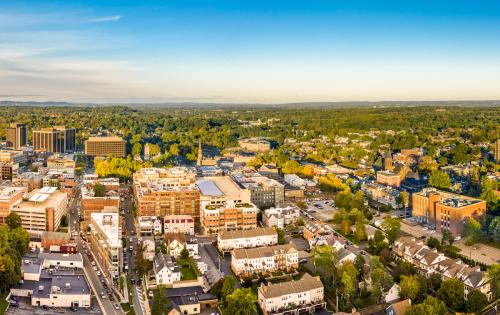Who would have thought one year ago that economists and investors would be celebrating a jobs report showing payroll employment fell “only” 540,000 in a month? But that seems to be the case. April’s job loss of 540,000 looks pretty good when the monthly drop of payroll employment in the previous four months averaged 700,000. To be sure, the monthly drop in private sector jobs still looked awful in April. Part of the improvement in overall employment loss is explained by a big jump in federal government employment, much of it due to hiring for the 2010 Census. Even in the private sector, however, the pace of job loss slowed, reflecting a slower rate of employment shrinkage in both the goods-producing and service-producing sectors. It no longer looks as though the job market is in free fall. It is still in decline, but the decline is not accelerating. It may be slowing.
The April statistics on initial unemployment insurance (UI) claims also gave us a hint the layoff rate may have slowed. The percentage of UI-covered workers who are losing their jobs and filing a new UI claim fell modestly in April. Since reaching a peak near the end of March, the weekly new-layoff rate has fallen about 10% Of course, the layoff rate remains terribly high. In April, slightly more than 2% of workers in UI-covered jobs filed a new claim for unemployment benefits. That’s almost twice the new-layoff rate we experienced in 2007, before the current recession began.
Many people may be surprised to learn that the peak layoff rate in late March 2009 was only modestly higher than the peak rate in the early 1990s, and it was far below the peak rate we experienced in the 1981-1982 recession. People who were distressed by the record number of new claims for UI this past winter should bear in mind that the historical number of new UI claims can only be assessed relative to the number of workers who hold jobs that are covered by the unemployment insurance system. Because the U.S. population has grown, the number of UI-covered workers is much larger today than it was in the 1980s and early 1990s. The shockingly high number of people filing new UI claims last March must therefore be weighed against the much larger number of workers who are at risk of being laid off and filing a claim for benefits. Today’s laid off workers might be a little less likely to file a claim for UI benefits than was the case for laid off workers back in 1982 or 1991, though it’s hard to see why. Workers in many states can now obtain more than a year of UI benefits after they file a successful claim. The maximum permitted spell of UI compensation was shorter in the 1980s and 1990s. In addition, the 2009 federal stimulus package provided a boost in UI benefits of $25 a week, giving laid off workers an extra incentive to file a claim.
The payroll employment numbers and the unemployment insurance statistics gave us the first indicator we were heading into a recession last year. In the first half of 2008, when the GDP statistics still showed a growing economy, the employment and unemployment statistics provided clear signals of rising distress in the job market. The latest statistics on payroll employment and UI claims may be giving us a hint that, while the economy is still shrinking, the pace of decline is slowing. That’s good news if you feared a recurrence of the Great Depression.



Commentary
Op-edHave Job Losses Peaked?
May 11, 2009